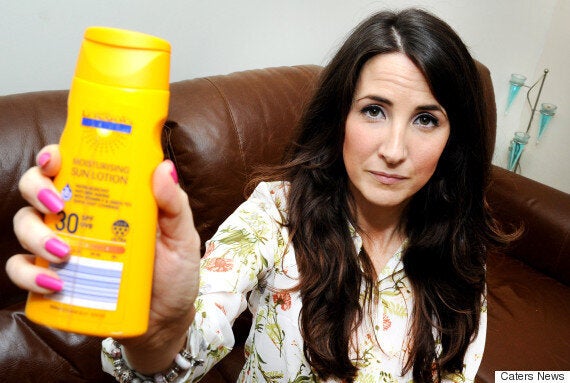A former tanning salon owner who was addicted to sunbeds is now spending £2,500 per year on SPF products after battling skin cancer.
Laura Creane, 31, from Leamington Spa, was diagnosed with the deadliest form of skin cancer, malignant melanoma, after using sunbeds at least twice a week.
Creane, who is naturally fair skinned, now has to plaster herself in thousands of pounds worth of high-end SPF products every day - regardless of the weather.
She said: "I just don't want to risk the cancer returning, it was the most terrifying time of my life."

Laura Creane now spends £2,500 on SPF products to protect her skin
Creane, who is now a sales administrator said: "No-one ever thinks they will get skin cancer, I was one of those people and I was naïve.
"I'm now terrified of the sun so I spend an absolute fortune every year buying the best SPF products including sun cream, foundation, shampoo and conditioner.
"Applying SPF has become a part of my daily routine, I cake myself in all my products as I'm so scared that the cancer will return."
Estimated cost of Creane's monthly SPF products:
£30 – sun cream
£35 – SPF foundation
£40 – SPF face cream
£50 – SPF shampoo
£50 – SPF conditioner
Creane added: "You just can't be too careful, women and men are still using sunbeds every day and wearing low factors on holiday and they don't realise the damage they're doing to their skin – I certainly didn't.
"When I was diagnosed with skin cancer my whole world came crashing down, I was beside myself with worry, and it was all just for vanity.
"Now I realise how silly I was, there's plenty of ways to look tanned without causing harm to your body like fake tan and spray tans."
Creane said that some people might think she's "over the top" for spending so much on SPF products but added: "You really can't take enough care of your skin, come snow, rain or shine I always apply protection now."
At the age of 17, Creane became obsessed with using sunbeds after getting a job at a beauty salon. She would only apply low factor sun creams on beach holidays.
Eight years later in April 2010, she was diagnosed with malignant melanoma after spotting a black mole on her stomach.
She said: "I had gone for a facial when they told me I should get a mole checked out on my face, I'd recently noticed a mole had changed colour so as a precaution I went to the doctors to have them checked out.
"I didn't think anything of it really, but days later I got a call from the hospital and I just knew it was bad news.
"I was in complete shock but I didn't even have time to process everything as I was sent straight for an emergency operation to remove the cancerous mole and cells from my stomach.
"I really thought I was going to die, I knew how aggressive my particular cancer could be and I was so frightened."
SEE ALSO:
Woman With Advanced Skin Cancer Shares 'Life Or Death' Warning
Over the past six years, Creane has had five more moles removed from her legs and stomach.
"I've got one 6cm scar and lots of other little scars and I will need to have more moles removed in the future too," she said.
"People often think that having a mole removed won't hurt, but I have to have more skin than most removed which means long, deep cuts and stitches.
"They can take weeks to heal and I've been left with five scars – I dread going for my check-ups in case it's bad news again."
During her latest check-up, Creane's consultant became concerned when she noticed another mole had turned black on her leg.
The 31-year-old said: "I felt like I had gone back six years, but thankfully after having the mole removed I was given the all clear again.
"I feel lucky to be alive after my cancer was found early and live every day to the full now.
"My whole outlook on life has changed and I will only eat healthy organic foods now I've realised how important it is to be aware of what you're doing to your body."
Creane has urged others to check their moles regularly, wear high SPF and stay clear of sunbeds.
She said: "If I can get skin cancer, anyone can, I never thought it would be me but it was."
After beating the deadly disease, Creane has become a keen fundraiser for the British Skin Foundation – she now plans to raise as much awareness as possible.
Offering advice for checking for skin cancer, Dr Bav Shergill, a consultant dermatologist and British Skin Foundation Trustee, said: "The best way to detect skin cancer is to check your skin regularly, you should examine the skin all over your body, from top to toe.
"Look out for moles or patches of skin that are growing, changing shape, developing new colours, inflamed, bleeding, crusting, red around the edges, particularly itchy, or behaving unusually.
"Seven people die from skin cancer every day in the UK and over 100,000 new cases are diagnosed in the UK each year.
"Some sun safety tips are to protect your skin with clothing, don't forget to wear a hat and spend time in the shade between 11am and 3pm when it's sunny.
"When choosing a sunscreen look for a high protection SPF (SPF 30 or more) and apply plenty of sunscreen 15 to 30 minutes before going out in the sun, and reapply every two hours and straight after swimming and towel-drying."
He added: "Remember, if in doubt, get it checked out straight away."
